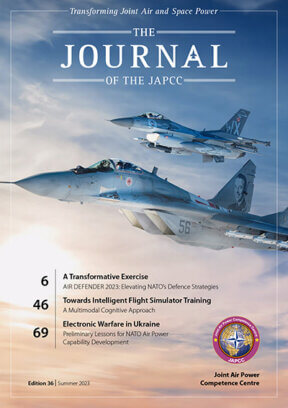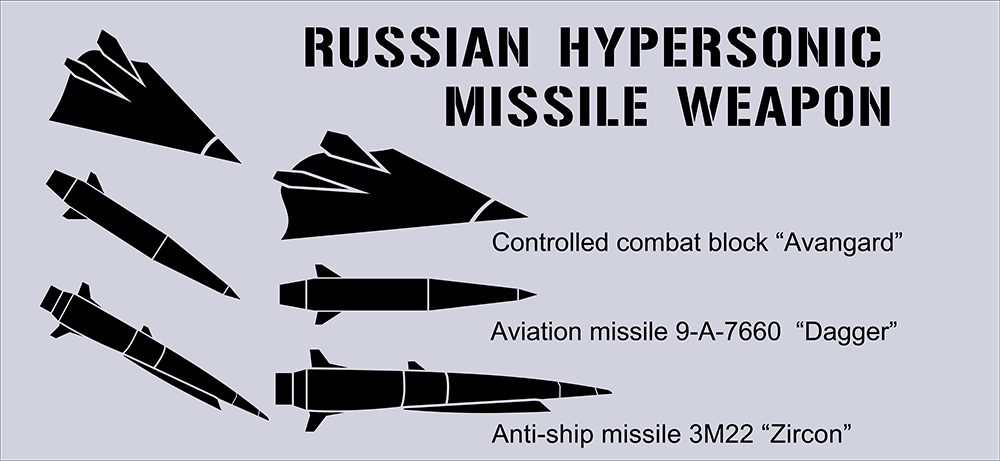Introduction
Some regard hypersonic weapons as a niche capability that offers a new first-strike capability for a small set of high-value targets, while others argue they have little real impact beyond strategic messaging of national prestige – a national prestige that NATO nations do not currently possess. The United States (US) and France have tested early versions with limited success, whereas Russia has fielded Avangard via land-based missile forces, Zircon in its Navy, and the Kinzhal from its Air Force. The Kinzhal (Kh-41), currently deployed for combat in the Russo-Ukrainian war, has received significant media attention despite its limited accuracy and effect.
Hypersonic technology presents new opportunities for adversaries to enhance national pride and introduce greater ambiguity during crises. It also has the potential to level the playing field by shifting the strategic balance of power away from those with a previous defensive advantage and towards a new offensive capability. By utilizing hypersonic capabilities, adversaries can introduce a higher degree of uncertainty and complexity, making it more difficult for defensive systems like NATO’s Ballistic Missile Defence (BMD) to counter these threats effectively. BMD’s success at deterring attacks highlights the evolving nature of strategic deterrence, and this success must be considered in the face of hypersonic advancements. NATO must prioritize the ability to defend against hypersonic weapons over the development of our own national pride to return the strategic balance in our favour.
Hypersonic weapons travel at speeds greater than Mach 5 without following a standard ballistic missile profile. Hypersonic weapons achieve their immense speed in one of two ways: using advanced engines as the high-altitude cruise missiles or as glide vehicles flying a depressed trajectory using the potential energy available to ballistic missiles. This combination of speed and altitude leads to significantly less reaction time compared to ordinary cruise or ballistic missiles. Both China and Russia have fielded hypersonic weapons, whereas India, the United Kingdom (UK), the US, and France are in various stages of development. This article briefly overviews the applicable history, ongoing developments, and possible impacts to strategic deterrence of hypersonic weapons.
© Dvorko Sergey/Shutterstock.com
History
The US has been developing hypersonic vehicles since the 1950s but paused at the end of the 1980s. By contrast, ‘Russia and China made the opposite decision. Instead of mimicking our restraint as we hoped, they developed and deployed increasingly sophisticated and numerous hypersonic capabilities of various types – including nuclear-capable and orbital hypersonic weapons’.1 Instead of developing a hypersonic offence, President Ronald Reagan initiated the Strategic Defense Initiative (SDI), an anti-ballistic missile programme designed to shoot down nuclear missiles in space. Otherwise known as ‘Star Wars’, SDI sought to create a space-based shield that would render nuclear missiles obsolete.2 Reagan, known as the US president who ended the Cold War, knew that having the ability to defend was far more important than increasing stockpiles of ballistic missiles.
The advent and successful fielding of BMD via the US Navy’s Aegis weapon system and the Army’s Terminal High Altitude Area Defense (THAAD) system meant that NATO’s adversaries could no longer be confident that their strategic nuclear weapons would reach their targets. In March 2018, Putin addressed the Russian Federal Assembly and proclaimed that ‘the US is permitting constant, uncontrolled growth of the number of anti-ballistic missiles, improving their quality, and creating new missile launching areas. If we do not do something, eventually this will result in the complete devaluation of Russia’s nuclear potential. Meaning that all of our missiles could simply be intercepted’.3 That same year US Missile Defense Agency (MDA) published test results from the THAAD, Aegis, and ground-based midcourse defense (GMD) systems revealing 100%, 77%, and 57% success rates, respectively. ‘Testing to date has given us confidence in the basic design, effectiveness, and operational capability for short-, medium-, and long-range ballistic missile defense’.4 While not precisely as Putin feared, the fact sheet did show an incrementally growing capability with a success rate that continues to improve. Russia later claimed that President Obama’s European Phased Adaptive Approach (EPAA) initiated by President Obama, which brought US BMD capabilities to Europe to defend against Iran, was ‘fuelling a new arms race’ and that is constructed ‘on ridiculous fabricated pretexts’. Dmitry Rogozin, the Deputy Prime Minister of Russia, further elaborated: ‘Russia vehemently opposes the plan, claiming that its own ballistic missiles would also be covered by the US shield, disrupting the nuclear parity between the countries’.5
At the 2016 Warsaw Summit, NATO leadership declared the Initial Operational Capability (IOC) of NATO BMD, and individual nations committed to developing or acquiring their own BMD contributions for the defence of the Euro-Atlantic area. A European consortium consisting of Airbus, BAE, Leonardo, and Thales developed and successfully tested ASTER-30 missiles in a BMD role in the Sol-Air Moyenne-Portée/Terrestre (SAMP/T) system against Short-Range Ballistic Missiles (SRBM). Fielded in land-based batteries, destroyers, and frigates, ASTER-30 can provide terminal defence and promises expanded capabilities in 2025 against medium-range ballistic missiles.6 The combination of US and European efforts are slowly degrading Russia’s confidence in the credibility of their offensive weapons.
Ongoing Developments
The Council of the European Union (EU) TWISTER (Timely Warning and Interception with Space-based TheatER surveillance) project was approved on 12 November 2019 to provide a ‘new endo-atmospheric interceptor [that] will address a wide range of threats including manoeuvring intermediate ranges ballistic missiles, hypersonic or high-supersonic missiles’.7 Led by MBDA (Matra, BAe Dynamics, and Alenia), the new missile system has an expected in-service date of 2030 with a range of 3,000 km, providing coverage for both hypersonic weapons and Intermediate-Range Ballistic Missiles (IRBM).
The US continues to develop its Aegis combat system by expanding its NIFC-CA (Naval Integrated Fire Control-Counter Air) programme to include F-35s, which enables Aegis BMD ships to shoot beyond line of sight using radar data from NATO’s newest aircraft.8 Several nations have bought Aegis or the ASTER-30, showing that Putin’s fears could be fully realized in the next few years as those systems are fielded in larger numbers throughout multiple NATO nations. For example, the US Navy will have 53 BMD-capable ships by the end of 2024.9 However, we must consider how hypersonic weapons are different from the ballistic missiles that have underpinned nuclear deterrence for more than 70 years.
‘The NATO nuclear arsenal is significantly larger than the Chinese arsenal and more survivable than the Russian and Chinese nuclear triads.’
Hypersonic weapons combine the speed of ballistic missiles with the accuracy of cruise missiles, travelling in a rarely used portion of the air domain and exploiting an untested vulnerability in NATO Air Defence systems. Hypersonic weapons’ speed and ability to manoeuvre means they will hit their targets within minutes of launch and do not necessarily follow a predictable flight path. In contrast, a ballistic missile’s high-parabolic path allows surface-based systems to detect them early and predict their likely trajectories. Our current standalone systems have a mere three minutes to run the full Find, Fix, Track, Target, Engage, and Assess (F2T2EA) kill-chain against a hypersonic weapon. Networking sensors together, as TWISTER and NIFC-CA envision, will enable earlier detection, tracking, and engagement using assets such as the F-35, Northrop Grumman E-2D Hawkeye, and future Alliance Airborne Early Warning Capability such as Boeing E-7 Wedgetail or Airbus Modular Multi-Mission Aircraft (A320M3A). Better networking of our terrestrial, air, and space sensors will ensure terminal success and enable earlier engagements.
The US MDA and TWISTER are both working towards creating a persistent and resilient space-based tracking layer enabling earlier detection and engagement of ballistic and hypersonic threats. MDA and the US Space Force partnered with SpaceX to launch the first batch of a new tracking and communications constellation as the first step towards creating a space-based tracking layer.10 Connecting via the US Naval Research Laboratory, these new satellites will demonstrate ‘multi-phenomenology ground-based sensor fusion’ expanding Aegis BMD’s ability to engage advanced missile threats at the edges of current missile capabilities.11
The Impact on Deterrence
Hypersonic weapons’ speed and ability to manoeuvre complicate target engagement as well as decision-making at the political and strategic levels. China and
‘NATO does not need hypersonic weapons to assure its strategic security, and their use would probably be limited to countering adversary A2/AD capabilities.’
Russia’s intentions to equip hypersonic missiles with nuclear warheads create strategic ambiguity when determining how to respond to a hypersonic weapon attack. Their speed shortens the Observe, Orient, Decide, and Act (OODA) loop, increasing the risk for a nation to assume the worst possible outcome; ‘the consequences of which will not only alter military balances but also have a psychological impact on decision-makers during crisis’.12 At the extreme, political leadership may assume an inbound hypersonic weapon as a ‘first strike’ intended to destroy their nuclear arsenal and retaliate in accordance with strategic doctrine by launching their own nuclear weapons.
For example, hypersonic weapons undermine how No First Use (NFU) countries, such as China and India, view nuclear deterrence. A nation’s nuclear arsenal sits at risk of quick destruction through the advent of global hypersonic strikes with conventional warheads. China, having a comparably smaller and less survivable nuclear triad, believes they will need to ‘use asymmetric retaliation to dissolve the enemy’s determination to conduct further hypersonic strikes’.13 Chinese think tanks argue this implies that China may launch nuclear retaliation against a conventional hypersonic strike. Similarly, in response to the perceived Conventional Prompt Global Strike (CPGS) threat from the US, experts believe China will adjust its long-standing unconditional NFU policy to a conditional one, i.e. China is willing to launch nuclear retaliation once its nuclear weapons are struck by conventional weapons.14
On the flip side, Forbes magazine argues ‘hypersonic weapons – with their combination of assured penetration, tailored effects and credible utility – have the potential to make a significant contribution to strategic deterrence. They will never replace nuclear weapons in the deterrence calculus, but they can make the use of America’s most fearsome warfighting systems less necessary even in extreme circumstances’.15 Hypersonics do offer the ability to take an adversary by surprise as well as nullify many air defence systems currently in use, however maturing the technology remains elusive.
Despite years of early research, the US lags behind Russia and China in fielding hypersonic weapons. The US Congress has enacted an accelerated profile to develop and test hypersonic weapons adding 0.9 Billion Dollar to the Department of Defense’s FY23 funding request, bringing the total to 4.7 Billion Dollar.16 By comparison, the UK’s hypersonic weapon development budget is roughly 13% of the US budget for FY23 with a total of 2.5 Billion Dollar budgeted from FY22-26. A significant disparity exists between the investments in hypersonic defence and offence in the US budgets. In FY22, 255 Million Dollar was allocated for defence against hypersonic weapons, while offensive hypersonic development received approximately sixteen times that amount. Meanwhile, the EU budgeted 100 Million Dollar in FY22 for the Hypersonic Defence Interceptor Study (HYDIS), which concludes in three years, whereas the UK and France have budgeted significantly more for the development of their own hypersonic weapons. ‘Effective deterrence leverages both the threat of punishment and a credible capability to deny an attack’ and, similarly to BMD, the results from the ongoing hypersonic defence investment will show our adversaries a credible defence.17 The current budget profiles do not support fielding of a credible defence until the mid-2030s whereas a US hypersonic weapon may finish testing in 2028.
While the US’s surging offensive hypersonic budget is quickly catching up with Russia and China, the US policy for hypersonic weapons use is not public, leaving think tanks to debate likely policy options. Policy experts profess mixed opinions on hypersonics and their usefulness in war. In one perspective, ‘hypersonic effects will most likely be felt on the sub-strategic level. This may include the ability to frustrate local defences and to provide rapid strike capabilities against locally deployed armed forces, especially in naval warfare, and high-value, time-sensitive, and hardened targets’.18 Conversely as a first strike weapon hypersonics offer the ability to take an opponent by surprise, striking high-value assets, such as aircraft carriers, land-based headquarters, or high-end air defence systems, allowing for follow-up strikes with cheaper cruise or ballistic missiles in large volleys. Hypersonic weapons could also be a solution to counter adversaries’ modern long-range Anti-Access/Area Denial (A2/AD) systems.19
Russia and China are developing their hypersonic weapons to be both conventional and nuclear-capable, increasing the survivability and diversity of their nuclear triads in response to NATO’s capability to defend against ballistic missiles. NATO nations (US, UK, and France) have publicly stated that their hypersonic weapons will not be nuclear-capable, in an effort to de-escalate the perceived threat hypersonics place on our adversaries’ deterrence calculus.
Conclusion
‘Deterrence is most likely to be successful when a prospective attacker believes that the probability of success is low and the costs of attack are high’.20 The NATO nuclear arsenal is significantly larger than the Chinese arsenal and more survivable than the Russian and Chinese nuclear triads. NATO does not need hypersonic weapons to assure its strategic security, and their use would probably be limited to countering adversary A2/AD capabilities. Negatively, ‘hypersonic weapons can increase pre-emption fears and dangerously alter crisis escalation scenarios’ further destabilizing deterrence, whereas investing in a larger arsenal of cruise missiles is significantly cheaper.21 Considering the potential savings and hypersonic weapons’ negative impact on strategic deterrence it would be prudent for NATO nations to prioritize funding for defence against hypersonic weapons thus decreasing the probability of an adversary’s successful attack and returning the strategic balance once again in our favour.













